
Related
Army Specialist Jeremy Morlock is the first of twelve US soldiers accused of forming a secret “kill team” in Afghanistan that murdered unarmed Afghan civilians at random and collected body parts, such as fingers, for trophies. They are also accused of using hashish, dismembering and photographing corpses, and possessing human bones such as a skull and leg bones. The Army is attempting to prevent the release of dozens of photographs that reportedly show Morlock and other soldiers posing with the murdered Afghan civilians. [includes rush transcript]
Transcript
AMY GOODMAN: A US soldier charged with murdering civilians and other crimes in Afghanistan made his first court appearance at a military court in Washington state Monday. Army Specialist Jeremy Morlock is the first of twelve US soldiers accused of forming a secret “kill team” in Afghanistan that murdered unarmed Afghan civilians at random and collected body parts, such as fingers, for trophies. They are also accused of using hashish, dismembering and photographing corpses, and possessing human bones such as skull and leg bones.
Earlier this year, Morlock was interviewed by Army investigators and acknowledged his role in the deaths of the three Afghans which took place in Kandahar between January and May. Video of part of Morlock’s confession to Army investigators has been leaked to the media. In the video — and you have to listen carefully — Morlock admits Staff Sergeant Calvin Gibbs ordered him to kill an innocent unarmed Afghan civilian.
JEREMY MORLOCK: And then he kind of placed me and Winfield off over here, so we had a clean line of sight for this guy. And, you know, he pulled out one of his grenades, American grenade, you know, popped it, throws the grenade, and then tells me and Winfield, “Alright, wax this guy. Kill this guy. Kill this guy.”
ARMY INVESTIGATOR: Did you see him present any weapons? Or did he —- was he aggressive at you at all? Did he -—
JEREMY MORLOCK: No, not at all. Nothing.
ARMY INVESTIGATOR: OK.
JEREMY MORLOCK: He wasn’t a threat.
AMY GOODMAN: On Monday, Morlock’s attorney, Geoffrey Nathan, defended him, saying Morlock was taking a variety of prescription drugs issued by the military to treat injuries he sustained in battle. He also linked the killings to overall US policy in Afghanistan.
GEOFFREY NATHAN: We believe that a jury will exonerate Morlock as a consequence of both a failed policy, a failed medical practice compounded with a failed policy. Let’s face it. Why are we still in Afghanistan? What are we accomplishing over there, other than taking good kids through multiple tours of duty, extending them, enlarging them, and then, frankly, ruining them? You know, this family has been torn apart by this, and it’s unfair to them. He should have never been there at all. He didn’t need to be there. And we believe that the combination of a failed policy emanating out of the White House and the demonstrative scientific evidence that I put forward today will indeed exonerate Morlock.
AMY GOODMAN: The Army is attempting to prevent the release of dozens of photographs that reportedly show Jeremy Morlock and other soldiers posing with the murdered Afghan civilians. A top Army official recently ordered that any images of dead or wounded Afghans may not be made public during Morlock’s hearing. Morlock is the first of five soldiers accused of murder. Seven others are accused of trying to block the investigation.
Chris McGreal is the Washington correspondent for the London Guardian. He has been following this story. He joins us on the line from Washington, DC.
Welcome to Democracy Now!, Chris. Can you lay out how this story was exposed and, well, what’s happening now with this hearing? Who is this kill team?
CHRIS McGREAL: This kill team is particularly striking incidents of organized killing of civilians, in that it seems to have been premeditated. And if we believe the accounts of some of the soldiers involved in court, including Jeremy Morlock, who you’ve just mentioned, it was instigated by the Staff Sergeant Calvin Gibbs after he arrived from a tour of duty in Iraq. And in discussions in which he is said to have sounded out the other members of his unit, to do something along these lines, which he seems to have done as well in Iraq, he certainly seems to have implied that he did this kind of thing in Iraq. He talked about setting up a kill team for a month within his unit who might be interested. Jeremy Morlock, who was a specialist, Army specialist, at the time, seems to have sided with Calvin Gibbs. Other soldiers were brought in. And then they simply set about identifying innocent Afghans, who, when they were on patrol, they plucked out just because they felt like it and then set about killing them.
In some cases — one particular man, which Jeremy Morlock talks about, he was taken from his home. He was told to stand against a wall. He wasn’t given — he wasn’t armed. He wasn’t any kind of threat. He wasn’t told why he had been taken out of his home. And then Morlock and Gibbs walked the other side of the wall and dropped a grenade over, and then went round, and if the man was still alive, they shot him.
So, it seems to have been a practice that Gibbs brought from Iraq, and he seems to have felt that he could get away with it. It was eventually uncovered because one member of the unit who knew about it had also noticed that bound up will all of this was very heavy drug use, or regular drug use, anyway, and he went to report it. When he reported that to one of his superiors, word got back to Gibbs and others, and they beat him up and tried to prevent him from reporting anything else. He went back to other officers, and once he was talking about why he’d been beaten up, which was over the drugs, then the information about the kill team came out.
AMY GOODMAN: The hearings are taking place at Joint Base Lewis-McChord in Washington state. The soldiers in the Third Platoon, Bravo Company, Second Battalion, First Infantry Regiment of what’s now the Second Stryker Brigade?
CHRIS McGREAL: Yeah, that’s right.
AMY GOODMAN: And talk about the soldier who contacted his father.
CHRIS McGREAL: Well, the Army is saying that the fact that they moved so swiftly — once they were informed about all of this, they moved swiftly to break up the kill team, and they’re using that as evidence that this kind of conduct is not tolerated inside the military. But it seems that at least two soldiers had, in one way or another, contacted the authorities and, in one case, contacted a parent to say that this was going on. The information did reach back to the military, and they seem initially not to have acted upon it. Certainly, the information filtered up within Gibbs’s own unit, and nothing seems to have been done. And it would seem that there’s some merit to the claim that it was initially covered up, because if we look at the charges, although five soldiers are charged with murder, seven others are charged with essentially trying to cover up the crime, which means that at least twelve soldiers within this unit knew it was going on. And if twelve knew, it’s highly likely that a lot more knew about it.
AMY GOODMAN: This was Specialist Adam Winfield, twenty-one years old, who said he told his father. And the father said he — he reached his father through Facebook, and the father said he tried to contact the base and was told that Adam, the soldier, had to report to his superiors, but his superiors in Afghanistan were part of this. This is exactly who he was afraid of.
CHRIS McGREAL: Yeah. It really only seems that this case was dealt with when it moved outside of the authorities immediately responsible for this unit in Kandahar. Once other investigators were brought in, principally over the assault of the soldier for reporting the drug use, then it essentially moved beyond the unit and the military authorities in Kandahar, and it became harder for the military to contain it.
AMY GOODMAN: Chris McGreal, what about the photographs? I mean, we know what happened with Abu Ghraib. Those photos got out. President Obama has sided with the Bush administration in not allowing the release of other photos in other cases. But now you have this group of photos that — can you describe them? What exactly is this evidence of?
CHRIS McGREAL: Well, I have not seen the photos, but we do have descriptions of the photos. Essentially, what they appear to be is a series of photos in which dead Afghans are treated as though they are hunting trophies, with soldiers posing by them as though they had been on safari in Africa a century ago, which of course is revealing of all kinds of things but also very demeaning of the dead in the photos. I’m sure the military and the American authorities don’t want them to come out, because I suspect they will be deeply upsetting to many Afghans and will confirm what many Afghans already feel, which is that there is an indifference towards all life, including Afghan civilian life, in — within the coalition forces, and particularly the US forces. We don’t know — I personally don’t know how many of these photos there are and who exactly is in them, although it is known that there are quite a few of them, and it does seem to have been part of a regular practice. Again, there seems to have been a culture of this as part of how this unit went about its daily duties.
AMY GOODMAN: According to Craig Whitlock in the Washington Post, digital photographs of the corpses and of soldiers posing with them circulated widely among the unit soldiers, who stored the images on laptops and thumb drives, according to court papers. Investigators have tried to collect all the images, but Army officials are worried they could become public and possibly inflame tensions among Afghans. Several other soldiers have also given statements to investigators, saying hashish was rampant in the unit and that some members kept Afghan finger and leg bones as trophies. Chris McGreal?
CHRIS McGREAL: Yes, I mean, there’s seems to — it’s clear that this is all part of, you know, a much bigger culture. If you have, I suppose, a staff sergeant who arrives from Iraq saying that, you know, he’d like to carry on doing what he did in Iraq, it’s clear that this is much wider than just this unit. But, yes, they seem to have appear — they appear to have been free — felt they were free to pretty much do what they liked, to select victims — that one of the prosecutors has called this “sport,” effectively, that they killed for sport. And I think their behavior suggests that. Having killed for sport, they then collected the trophies, the fingers and bones and the skull, and they took — they took photographs of their kills and next to their kills. And the general approach towards this does seem to have been to treat it as though killing Afghan civilians was sport.
AMY GOODMAN: Chris McGreal, you know, this story was breaking during the whole Terry Jones scandal, the pastor who was going to burn a Quran on September 11th, this one pastor, a lot attention on that. But this, which is so much more explosive and involves so many other people, this has been now brewing for a while. The hearings already started on the base. And yet it’s gotten very little attention in the United States.
CHRIS McGREAL: Yes. Well, it seems to have got a little bit more attention recently in the run-up to the hearings, but it’s true. Perhaps — it is not clear to me why, because it was written about by the press in Seattle when the charges were first laid back in May, and it has been written a bit about by the Associated Press. But it’s only now that it’s caught attention here. I’m not entirely sure why that is. But as you say, it seems to have been a long time coming.
AMY GOODMAN: Finally, very quickly — I know you have to go, Chris. You’ve written about Hamid Karzai, the Afghan president, breaking down and crying, talking about not wanting his son to be a refugee, wanting Afghans to able to stay in Afghanistan. Talk more about what took place.
CHRIS McGREAL: Well, this was — he was actually at a school for International Literacy Day, but it came on the day that they were launching the High Peace Council, which is essentially going to be the body that is going to try and negotiate with the Taliban and other insurgents and just bring an end to this war. And Karzai broke down while appealing to the people of Afghanistan to find some sense, as he put it, and put an end to this conflict.
I mean, I think that it was obviously a very emotional speech for him, and he feels that because he spent so many years in exile himself, first fleeing after the Soviet invasion of Afghanistan and then remaining in exile during the Taliban rule — his own father was murdered by the Taliban — and he knows the experience of exile and being victimized by oppressive forces.
I think, you know, his appeal, though, was a reflection of the fact that he actually doesn’t have much confidence now that this conflict is going to — or that the way this conflict is being conducted is going to end with the Taliban being defeated. He’s facing the reality that there has to be a deal with the Taliban in the end, and the only way to bring an end to the conflict is to bring all Afghans on board. And it was a very heartfelt appeal for that.
AMY GOODMAN: Chris McGreal, I want to thank you very much for taking this time, Washington correspondent for The Guardian in London.

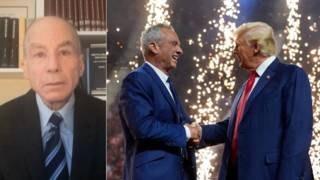

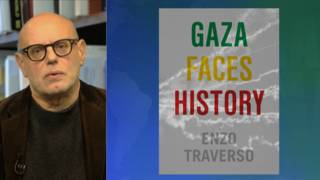
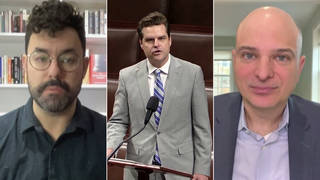





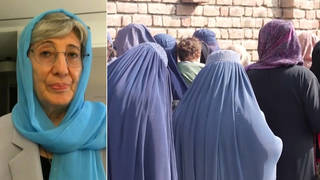
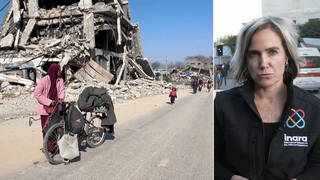
Media Options